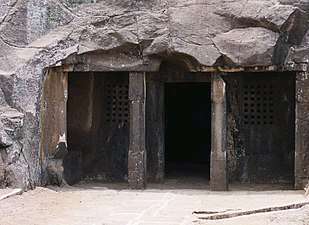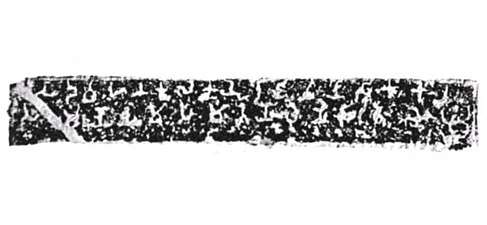Kanha (Satavahana dynasty)
| Kanha | |
|---|---|
| Satavahana king | |
| Reign | 1st century BCE |
| Predecessor | Simuka |
| Successor | Sri Satakarni (according to Puranas) |
| Dynasty | Satavahana |

Kanha (c. 1st century BCE) was a ruler of the Satavahana dynasty of India. Historian Himanshu Prabha Ray assigns his reign to the period c. 100-70 BCE.[2][1]
Kanha has been mentioned as "Krishna" (IAST: Kṛṣṇa) in the Puranas. According to the Puranic genealogy, he was the brother of the first Satavahana king Simuka (whose name varies according to the different Puranas).[3][4]
Nasik cave
Besides the legendary Puranas, Kanha's existence is also supported by an epigraphic record at Cave No.19 in the Nasik caves. He is identified with the "Kanha-raja" (King Kanha) of "Satavahana-kula" (Satavahana family) mentioned in a Nashik cave inscription.[5] The inscription states that the cave was excavated by maha-matra (officer-in-charge) of the shramanas (non-Vedic ascetics) during Kanha's reign. Based on this, Sudhakar Chattopadhyaya concludes that Kanha favoured Buddhism, and had an administrative department dedicated to the welfare of Buddhist monks. Also, the term maha-matra indicates that the early Satavahanas followed the Mauryan administrative model.[3]
Cave No19 at the Nasik caves is located on the ground floor, to the left of the entrance of Cave No.18, and right under cave No.20. Cave No.19 has one inscription mentioning the dedication by a government officer during the rule of king Krishna of the Satavahanas:
"Under King Krishna of the Satavahana family, this cave has been caused to be made by the officer in charge of the Sramanas at Nasik."
— Inscription of Cave No.19[6]
This makes Cave No.19 one of the earliest to be excavated at Nasik caves.[7]
References
| Satavahana Kings | |
| Simuka | (100-70 BCE) |
| Kanha | (70-60 BCE) |
| Satakarni | (1st BCE) |
| Sivasvati | (1st century CE) |
| Gautamiputra Satakarni | (2nd century CE) |
| Vasishthiputra Pulumavi | (2nd century CE) |
| Vashishtiputra Satakarni | (2nd century CE) |
| Shivaskanda Satakarni | (2nd century CE) |
| Yajna Sri Satakarni | (2nd century CE) |
| Vijaya | (2nd century CE) |
- 1 2 Empires: Perspectives from Archaeology and History by Susan E. Alcock p.168
- ↑ Carla M. Sinopoli (2001). "On the edge of empire: form and substance in the Satavahana dynasty". In Susan E. Alcock. Empires: Perspectives from Archaeology and History. Cambridge University Press. pp. 166–168. ISBN 9780521770200.
- 1 2 Sudhakar Chattopadhyaya (1974). Some Early Dynasties of South India. Motilal Banarsidass. pp. 37–38. ISBN 9788120829411.
- ↑ rao 1994, p. 10.
- ↑ D. S. Naidu (1970). Andhra Satavahanas: Origins, Chronology, and History of the Early Rulers of the Dynasty. Bharath. p. 80.
- ↑ Epigraphia Indica p.93 Inscription No.22
- ↑ Archaeological survey of India
Bibliography
- rao (1994), History and Culture of Andhra Pradesh: From the Earliest times to the present Day, Sterling Publishers, ISBN 81-207-1719-8
